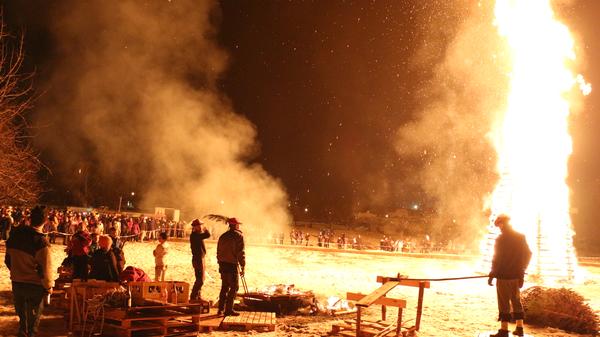Disc flinging
Social practices in Tyrol, Vorarlberg, inscribed 2015
Disc flinging (“Scheibenschlagen”) is practised in several places in southern Vorarlberg and Tyrol, usually on the first Sunday of Lent (also known as “Funkensonntag”, “Kassunnti”, or “Hexasunnti”). Special discs made of alder or birch are mounted onto 70-to-200 cm long hazel sticks, made to glow in the so-called "Vorfeuer" [preliminary fire], and then shot off the sticks with the help of a small wooden ramp built like a tilted bench. If a shot is successful, the glowing disc leaves a luminous arc-shaped trail in the dark night sky.
As the participants shoot, they call out sayings that address specific people from the community by name—honouring them, making fun of them, or even exposing secret romantic liaisons. Disc flingers are often young men, teenagers, and schoolchildren, but are primarily members of associations such as so-called spark guilds (“Funkenzünfte”) or the voluntary fire brigade.
It is no longer possible to ascertain the exact origins of this practice. Historical sources on disc flinging exist from as far back as the 17th century, though these actually often describe bans on the practice due to it being a fire hazard. When it is completely dark, the disc flingers take the glowing discs out of the fire with the hazel stick and swing the discs before knocking them over the disc stick and out into the night sky. A disc is dedicated to each household. The disc, which flies out like a rocket, is usually accompanied by a humorous reference to a special occurrence from the past year. The disc flingers aim to shoot their discs as high and as far as possible. Visitors gather at the same time at a place from which the discs’ trajectories can be observed particularly well. The day ends when all households have shot their disc and said their greeting, or a straw doll called “Hex" has been lit.
Over the course of the 20th century, disc flinging lost its importance in many places, but it has regained regional importance and found a resurgence in some parts, particularly in more recent years. Despite local variations, it has a supra-regional characteristic.
Contact
Downloads
- Application form (in German only) 114 KB (pdf)
- [Translate to EN:] Erweiterung Tirol 2022 159 KB (pdf)
[Translate to EN:] - Expertise Rudigier (in German only) 362 KB (pdf)
- Expertise Tschaikner (in German only) 434 KB (pdf)


![[Translate to EN:] © J. Ségur/ZED, with the permission of UNESCO](/fileadmin/_processed_/d/b/csm_Convention-2003-IKE_0832a6a47d.jpg)
![[Translate to EN:] © ÖUK](/fileadmin/_processed_/3/9/csm_P1011318_7eac86402f.jpg)

![[Translate to EN:] © Weitblickfilm](/fileadmin/_processed_/9/8/csm_Workshop_17_2dee1e1fd8.jpg)